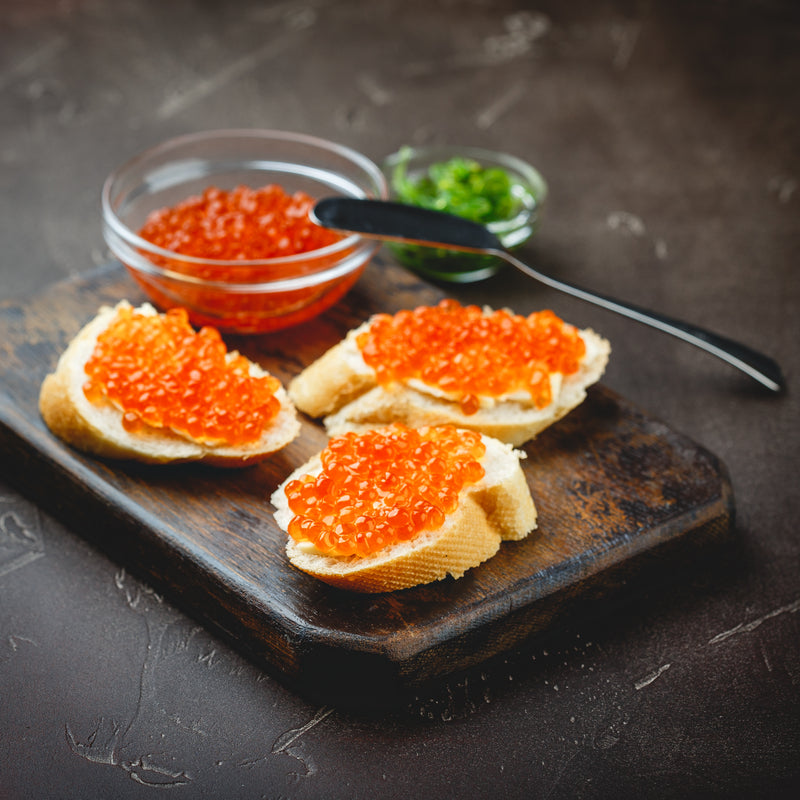Ikura vs. Caviar – Differences, Similarities, and Culinary Insights

Ikura vs. Caviar: Understanding
Both Ikura and Caviar are revered for their luxurious flavors and culinary versatility. While they may look similar at first glance, these seafood delicacies come from different origins, boast unique flavors, and are used in diverse ways.
In this guide, we’ll explore the differences and similarities between Ikura and Caviar, helping you appreciate these treasures of the sea.
What is Ikura?
Ikura is the roe (eggs) of salmon, celebrated for its vibrant orange color, large size, and oceanic flavor. It is especially popular in Japanese cuisine, where it is commonly used in sushi, rice bowls, and as a standalone delicacy.
Key Features of Ikura
- Source: Salmon roe, primarily from species like Coho, Pink, and Chum salmon.
- Appearance: Large, translucent orange spheres.
- Flavor: Mildly briny with a buttery finish.
- Texture: Firm and “pops” in the mouth, releasing a burst of flavor.
Ikura is often cured in light salt or soy sauce (Shoyu Ikura), enhancing its umami profile.
What is Caviar?
Caviar refers specifically to the roe of sturgeon fish, including varieties like Beluga, Ossetra, and Sevruga. Unlike Ikura, which is harvested from salmon, true Caviar is sourced from sturgeon species native to the Caspian and Black Seas.
Key Features of Caviar
- Source: Sturgeon roe, including Beluga and Ossetra.
- Appearance: Small, dark beads ranging from black to golden brown.
- Flavor: Rich, briny, with complex nutty undertones.
- Texture: Silky and delicate, melting in the mouth.
Caviar is typically cured using a method known as Malossol, meaning “low salt,” which preserves its delicate flavor.
Key Differences Between Ikura and Caviar
1. Source of Roe
- Ikura: Salmon roe, commonly from Coho, Pink, and Chum salmon.
- Caviar: Sturgeon roe, including species like Beluga and Ossetra.
2. Appearance
- Ikura: Bright orange, translucent, and larger in size.
- Caviar: Darker in color, ranging from black to golden, and much smaller.
3. Flavor Profile
- Ikura: Mild, briny, with a hint of sweetness and a clean oceanic finish.
- Caviar: Rich, nutty, and buttery, with a more complex flavor profile.
4. Culinary Use
- Ikura: Commonly used in Japanese dishes like sushi, rice bowls, and sashimi.
- Caviar: Traditionally served on blinis with crème fraîche or as a garnish for gourmet dishes.
5. Price Point
- Ikura: More affordable due to abundant salmon populations.
- Caviar: Considerably more expensive, as sturgeon roe is rare and labor-intensive to harvest.
Similarities Between Ikura and Caviar
Despite their differences, Ikura and Caviar share several qualities:
- Luxury Status: Both are considered gourmet delicacies.
- High Nutritional Value: Packed with omega-3 fatty acids, protein, and essential vitamins.
- Versatility: Can be enjoyed on their own or as part of sophisticated dishes.
- Cultural Importance: Both have significant roles in their respective culinary traditions—Caviar in European fine dining and Ikura in Japanese cuisine.
Nutritional Benefits of Ikura and Caviar
1. Omega-3 Fatty Acids
Both Ikura and Caviar are excellent sources of omega-3s, which support heart health, brain function, and inflammation reduction.
2. Protein Powerhouses
They provide high-quality protein essential for muscle repair and energy.
3. Rich in Vitamins and Minerals
- Vitamin D: Strengthens bones and boosts immunity.
- Vitamin A: Promotes good vision and skin health.
- B Vitamins: Improve energy levels and cognitive function.
- Selenium and Iodine: Support thyroid health and antioxidant protection.
How to Enjoy Ikura and Caviar
Serving Ikura
- Ikura Donburi: Serve atop a bowl of rice, garnished with nori and wasabi.
- Sushi: Use as a topping for sushi rolls or nigiri.
- Canapés: Pair with crème fraîche and blinis for a fusion twist.
Serving Caviar
- Traditional Style: Serve on blinis with a dollop of sour cream.
- Garnish: Add to seafood dishes, pasta, or deviled eggs.
- Caviar Butter: Blend with unsalted butter for a luxurious spread.
For more ideas, check out the Global Seafoods YouTube Channel.
FAQs About Ikura and Caviar
Q1: Can Ikura Be Called Caviar?
A: No, true caviar is exclusively the roe of sturgeon fish. Ikura refers to salmon roe.
Q2: Which Is Healthier, Ikura or Caviar?
A: Both are nutritionally rich, but Ikura typically contains higher omega-3s due to salmon's natural fat content.
Q3: Why Is Caviar More Expensive?
A: Sturgeon roe is rare and takes years to harvest, contributing to its high cost.
Explore Premium Ikura and Caviar at Global Seafoods
Discover the finest selection of Ikura and Caviar, including:
Conclusion: Choosing Between Ikura and Caviar
Whether you prefer the bold, briny flavor of Ikura or the delicate, nutty profile of Caviar, both are exceptional choices for gourmet indulgence. By understanding their differences and similarities, you can enjoy these delicacies to their fullest potential.
Shop premium Ikura and Caviar at Global Seafoods today and elevate your culinary adventures.
For more insights and recipes, visit the Global Seafoods YouTube Channel.
Indulge in the best of both worlds—Ikura and Caviar await!
Also in Recipes

Caviar on Toast – A Luxurious and Elegant Appetizer
Caviar on toast is the perfect blend of rich flavors, delicate textures, and gourmet sophistication. Whether you're preparing a special dinner party appetizer or treating yourself to an exquisite snack, this simple yet elegant recipe will elevate your dining experience. Learn how to create the perfect caviar toast with crème fraîche, lemon, and fresh herbs for a luxurious bite that impresses every time!

🔥 Black Caviar Recipes – Luxurious Ways to Enjoy This Delicacy
Explore luxurious black caviar recipes including blinis, deviled eggs, pasta, and more. Learn how to enjoy caviar like a gourmet chef.

🔥 How to Make Red Caviar Blinis – A Luxurious & Easy Appetizer
Learn how to make perfect red caviar blinis, a classic Russian appetizer featuring fluffy pancakes, crème fraîche, and luxurious red caviar.
